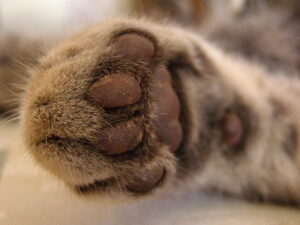Sweating in humans is a common sight. Sweating is essential to control body temperature. All mammals have sweat glands. Hence, it would be interesting if cats sweat and when.
Cats do sweat, even if we rarely notice them doing so. However, they do not sweat as much as many other mammals do. In fact, cats only sweat a small portion of what humans do. But, similar to humans, cats also sweat when they get too hot as a way to regulate their body temperature.
Key Takeaways:
| Topic | Summary |
|---|---|
| Sweating in Cats | Cats do sweat, but not as much as humans. They sweat primarily to regulate body temperature, similar to humans. |
| Sweating Signs in Cats | Cats sweat from their nose and paws, leaving moist footprints, especially in hot weather or stressful situations. |
| Cats’ Body Temperature | A cat’s ideal body temperature range is between 100 and 102 degrees Fahrenheit. They sweat through paws and nostrils to cool off when their body temperature rises above 102 degrees. |
| Cats’ Cooling Methods | Cats use various methods to cool down, including sweating, grooming, lying on cool surfaces, and seeking shade. |
| Recognizing Overheating in Cats | Overheating in cats can lead to symptoms like panting, lethargy, vomiting, unstable walking, and excessive drooling. It’s essential to monitor cats during hot weather to prevent overheating. |
| Sweating During Sleep | Cats have a polyphasic sleep cycle and may sweat while sleeping, especially if they feel overheated. |
| Sweating Due to Stress | Cats can sweat when stressed or anxious, typically through their paws. Wet paw prints may be a sign of stress, such as during a visit to the vet. |
| Sweating and Illness | Excessive and continuous sweating in cats can also indicate underlying health issues, so it’s essential to check for other symptoms and consult a vet if necessary. |
| Fever and Sweating in Cats | Fever can cause cats to sweat, with a body temperature exceeding 102 degrees Fahrenheit as a warning sign. Other symptoms of fever include shortness of breath, lethargy, and loss of appetite. |
| Cat Sweat Odor | Humans generally cannot smell cat sweat, but other cats may detect it due to their keen sense of smell. Cat sweat can have an odor used by cats for tracking and communication. |
| Panting in Cats | Cats rarely pant, but they may do so when stressed or overheated. Panting is not as effective as sweating for cooling, and persistent panting may require veterinary attention. |
| Cooling Down an Overheated Cat | To help an overheated cat, provide water, use fans, offer shady spots, avoid leaving them in enclosed spaces like cars, consider trimming their fur, and, in extreme cases, rinse them with cool water. Always consult a vet for excessive sweating and panting. |
Cats have evolved to adopt different methods of cooling themselves in the heat than sweating. As a result, on hot summer days, we frequently discover furry friends in cooler locations, such as restrooms, shady nooks, tiled kitchen floors, etc.
Cats can sweat for other reasons besides the heat, such as stress. For instance, a stressed-out cat at the vet’s office would frequently sweat through their paws. And the exam table frequently has wet footprints on it.

Jim Champion (CC BY-SA 2.0) from Wikimedia
Is sweating common among cats?
Cats have sweat glands much as humans do. Despite having fewer sweat glands than humans, cats’ sweat glands function similarly.
It’s normal for cats to sweat. Sweating is a basic mechanism in cats’ body that help to control their body temperature. As a result, they will perspire like humans do when they become overheated.
However, it is crucial to determine whether a cat is perspiring frequently and excessively despite a colder environment. If so, the cat may suffer from health problems, which may be indicated by excessive perspiration.
Do cats sweat through their fur?

Humans have sweat glands beneath their skin. And it’s rather obvious when we perspire. What about cats, though? Do they sweat through fur? Let’s unravel the truth.
Cats have sweat glands as well, and the glands are coated with fur. However, cats perspire from their nose and paws. As a result, your cat may frequently leave moist footsteps behind under stress or in high temperatures.
A few sweat glands are also in the skin beneath the cats’ fur. However, the actions of the glands are lessened by the hairy coating. As a result, they mostly sweat through their nose and paw pads.
Do cats sweat when it’s hot?
As summer days approach, we get really worried about sweating. Sweat and heat go hand in hand. So, isn’t it natural for our feline friends as well to sweat when it’s hot?
Cats do sweat when it is hot. But it is not the only time when cats sweat. As we have already stated, a frightened cat may also sweat profusely through its paw.
Having said that, sweating allows cats to cool off when it’s hot outside. In addition, cats’ paw pads provide them with cooling feelings when the sweat starts to disperse. Cats’ paws don’t cover a lot of space, though. As a result, they frequently turn to alternative techniques to relieve their heat. For instance, they might lay down under the bed, in a bathroom corner, or a shady area.
Where do cats sweat?
In cats, sweating is as common as it is in humans. However, we frequently wonder how cats genuinely sweat since we do not witness them becoming coated in wet, salty sweat.
Cats perspire via sweat glands. However, feline sweat glands are smaller than human ones. The paws, lips, chin, are only a few of the cat’s hairless places where these glands are situated. Cats, therefore, sweat through these regions.
However, just like people and other mammals, cats’ sweating system helps them lower their body temperature. As a result, they feel cooler from the sweat evaporating.
How much should a cat’s body temperature be?
While talking about cats’ sweating, it’s important to consider their ideal body temperature. So, let’s find out the answer.
Cats’ ideal body temperature range is between 100 and 102 degrees Fahrenheit. This is because the bodies of our feline friends are built to retain heat longer than ours. However, if their body temperature increases beyond 102, they begin to sweat through their paws and nostrils to cool off.
Compared to humans, cats are less sensitive to heat. Thus, although a temperature of 112 degrees or higher will make us uncomfortable, cats only experience discomfort at temperatures of 126 degrees or higher. A cat, however, can get a fever if its temperature exceeds 102 degrees.
What do cats do when they sweat?

Cats possess sweat glands. But their sweat glands do not do much to give them relief on hot summer days. So, what do cats do when they sweat?
Along with sweating through their paws, cats wet their furs, drink water, and lay in shady spots to cool themselves off. They also prefer to stretch out long on cool surfaces to release their body heat.
Self-grooming increases among cats during the summer. When the saliva evaporates off their fur, it gives them a cooling sensation.
How to tell if a cat is sweating?
Sweating signs in humans are very much apparent. However, we do not see our feline friends showing any apparent signs of sweating. So, how may we know if a cat is sweating?
The most obvious indication that your cat is sweating is its damp footprints. If the outside of your cat’s paws are dry, but you can still see obvious wet paw prints, your cat is sweating. A cat may also salivate on other occasions, which could indicate sweating.
However, excessive salivation can also be due to a dental or stomach problem. So, if you find your furbaby rolling excessively, you should consult a vet.
How to tell if my cat is overheating?
Increased body temperature during the summertime is a common phenomenon. But getting overheated is not a good thing. Hence, keeping a close check if your cat is getting overheated is crucial.
Despite being less susceptible to heat than people, house cats aren’t designed to survive intense heat. Cats exposed to high temperatures are susceptible to heat stress or heat stroke. Here are some symptoms that will help you determine whether your cat is overheating.
- Panting
- Lethargy
- Sweaty paws
- Vomiting
- Unsteadiness
- Unstable when walking
- Diahrrea
- Excessive drooling
Recognizing the causes of overheating requires an understanding of its warning indications. So, closely watch your cat and monitor its activity throughout the hot summer days, especially afternoons, to prevent any significant health issues caused by overheating.
Do cats sweat when they sleep?
Sweating is a natural process that, in humans, takes place anytime the body temperature rises. Is the process the same in felines as well? Let’s find the answer.
Cats have a polyphasic sleep cycle compared to the conventional human sleep cycle. Multiple, brief naps during the night are a sign of this. In addition, if a cat feels overheated, it may even sweat while sleeping.
Do cats sweat when stressed?
We humans often sweat profusely when under stress. It is pretty normal for us. However, if you have a cat at home, have you ever noticed it getting sweaty under stressful situations?
Apart from feeling overheated, cats sweat when under stress. Like humans, sweating is also a sign that shows the cat is frightened or highly anxious.
This is why you may find your pet having wet paws while visiting the vet. It may leave small wet patches on the examining table that are nothing but droplets of sweat.
Do cats sweat when ?
Cats’ sweating is not as straightforward as one may think. Sweating in felines can be associated with several conditions. And to understand your cat’s sweating, you should understand its reason.
Cats can sweat when sick. Cats do not just sweat when they feel heated during the summer months. Excessive and continuous sweating can also be a giveaway sign of illness.
We must realize that a cat’s brain would signal the sweat glands to sweat if its body temperature rises anytime. First, however, we must look into the causes of the cat’s elevated body temperature to identify the underlying cause. Only then can you accurately determine whether your cat is simply overheating or unwell.
Cats are tenacious animals. They would keep their illness hidden. Therefore, we are responsible for examining its paws and even the fur to determine whether they are wet or damp. In such circumstances, checking the temperature is also crucial.
Keep in mind that a fever that is regularly higher than 102.8 °F is a warning indicator.
Do cats sweat when they have a fever?
Cats’ bodies operate somewhat differently from humans’ bodies. So while we experience cold when we are feverish, cats might not.
In short, the answer to the above question is fever can cause cats to sweat. The primary cause of cat perspiration is an increase in body temperature. Felines with fever have elevated body temperatures, which force the brain to tell the sweat glands to create sweat. Hence, cats sweat when having a fever.
Therefore, given this situation, we can say that sweating may be a potential symptom that a cat may be ill or have a fever. Therefore, if your cat is consistently sweating despite the cold outside, you should check its body temperature. Fever may be present when the temperature exceeds 102 degrees.
Other symptoms of fever in cats, aside from sweating, include the following
- Shortness in breathing
- Unwillingness to move
- Low appetite
- Fatigue, etc.
Does cats’ sweat have any odor?
It might be really messy to sweat. It smells, makes us feel damp, and so on. But have you ever caught a whiff of your cat’s sweat? Does cat perspiration actually have a smell?
The answer to the above question is not straight. Humans cannot smell the odor of cat sweat. For cats, though, it might not be the case. Cats can smell the fragrance of other animals since they have a keen sense of smell.
Cat perspiration produces an odor that other cats may detect and utilize as a tracking system. As a result, cats spend most of their waking hours grooming to remove any odors that may have accumulated on various body regions.
Therefore, if your cat is perspiring and you can smell something unpleasant, there may be another cause. For example, your cat may smell if it has a skin condition.
Do cats pant to cool off?
Unlike dogs, cats rarely exhibit panting. However, panting in cats is typical, particularly when they are stressed.
Cats may pant if their body temperatures are too high. Panting, however, is not a very effective strategy to lower an elevated temperature. Therefore, if you notice your cat panting, it may require more assistance to cool off. It will help if you keep your cat in a shady area, give it water, turn on the fan or air conditioning, etc.
The primary function of panting is to facilitate the passage of heated air from the chest out of the mouth. It operates similarly to sweating. However, sweating is more efficient than panting. Therefore, persistent and severe panting may call for quick veterinary assistance.
How can you cool down your cat?
Sweating is a common temperature controlling mechanism in cats. However, it is not wise to leave a sweating cat as it is. A few things can be done to relieve an overheated and sweating cat.
Cat paws are not particularly effective in effectively cooling them down. As a result, it is possible to alter some outside elements to help lower a cat’s body temperature. Here is a list of things you can do to keep your furry friend cool during the sweltering summer months.
- Provide them a large bowl of water to keep them hydrated
- Direct fans towards your cat
- Provide the option for shady places
- Avoid keeping your cat in an enclosed area, like a car
- Trim their fur, if large and thick
- Rinse them with cool water- but do not do it frequently
- In case of excessive sweating and panting, take them to the vet
Frequently Asked Questions
1. Do cats sweat?
- Yes, cats do sweat, but not as much as humans.
2. How do cats sweat?
- Cats primarily sweat through their paws and sometimes their nose.
3. Do cats sweat when sick?
- Yes, cats may sweat when they are sick, especially if they have a fever.
4. Can cats sweat?
- Yes, cats have sweat glands and can sweat to regulate their body temperature.
5. Do cats have sweat glands?
- Yes, cats have sweat glands, although they are not as numerous as in humans.
6. Where do cats sweat?
- Cats sweat from areas with fewer fur coverings, such as their paws and nose.
7. Does a cat sweat when stressed?
- Yes, cats can sweat when stressed, often through their paws.
8. Do cats sweat through their fur?
- Cats primarily sweat through their paws and nose, not through their fur.
9. Why does my cat feel sweaty?
- If your cat feels sweaty, it could be due to overheating, illness, or stress.
10. Do cats sweat from their paws?
- Yes, cats sweat through their paw pads, leaving moist footprints.
11. Can cats sweat through their nose?
- Cats may sweat minimally through their nose, but paw pads are the primary area for sweating.
12. Where do cats sweat from?
- Cats sweat from specific areas like their paw pads and nose, which have fewer hair coverings.
13. Can a cat sweat?
- Yes, cats have the ability to sweat, although it’s not as prominent as in humans.
14. Do cats sweat through their paws?
- Yes, cats primarily sweat through their paw pads to cool themselves.
15. Do cats sweat from their paws?
- Yes, cats sweat from their paw pads, especially in response to heat or stress.
Summary
The ancestors of domestic cats lived in the desert. Cats enjoy lying in the warm sun because of their shared ancestry. Also, cats are less susceptible to heat than people are. House cats, however, cannot withstand intense heat. When their body temperature reaches 102 degrees, they begin to sweat. Felines primarily sweat through the nose and paw pads. So, understanding cats’ over-sweating is essential to offer them some cool relief.





